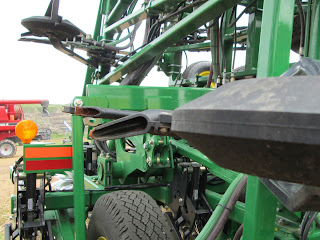We travelled north from Strathmore for about an hour without changing roads or direction, to Three Hills, where we were met by a Canadian Nuffield scholar, Steve Larocque. We had previously met Steve and his wife Vanessa at Niagra, during the CSC (Contempary scholars conference) in march. We were made very welcome at the Larocque household, and even the children accepted us after sizing us up for a while.
 |
| Me, Steve and Jake
|
L: Non CTF R: CTF
Steve is an agronomist as well as running his own farm, his agronomy company is called Beyond Agronomy,(http://beyondagronomy.com/). Steve has a core of 10 clients and covers around 37,000 acres, he has also designed and sells apps for smart phones, such as seedrate calculators and Herbicide tank mix calculators.
Steve took us to see some of the machines that are commonly used in his area, at a local John Deere machinery dealer. The scale of the equipment is what first strikes you, but once you get beyond that the machines have some very good design features. Such as sectional control on the air seeders to reduce overlap and seed requirement, to a simple method for keeping the wheels on the air seeder free from soil in wet conditions. We looked at several tine (shank) type drills, I was most impressed by the Conservapak, as it had a short arm for contour following ability, low soil disturbance and reconsolidated to the side of the row rather than on top.
High Clearance Sprayer, with wheels retracted
Sectional control on an Airseeder
Simply wheel cleaning design
Conservapak seeding shank (Seed & Fertilizer)
After a Pub Lunch sponsored by Syngenta with some of Steve's clients and other farmers, (a free lunch and wet days have the same response all over the world!), we headed out to Starland Hutterite colony, and met farm boss Peter Stahl. The Hutterites area originally from Austria and there are now colonies all across Canada. Starland colony farmed 15,000 acres, growing crops, raising cattle, pigs and chickens (no sheep after they learnt how to start the auger from Peter's seed bins for a midnight snack) and embraced all new technology, from mobile phones to RTK Guidance on all there large modern equipment. It was a great pleasure to visit the colony and spend time with Peter, he made us very welcome and gave us food and wine to take with us. Steve showed us an example of inter row seeding at the colony, with wheat having been planted between the previous years canola rows.
Wheat inter row seeded between last years Canola






No comments:
Post a Comment